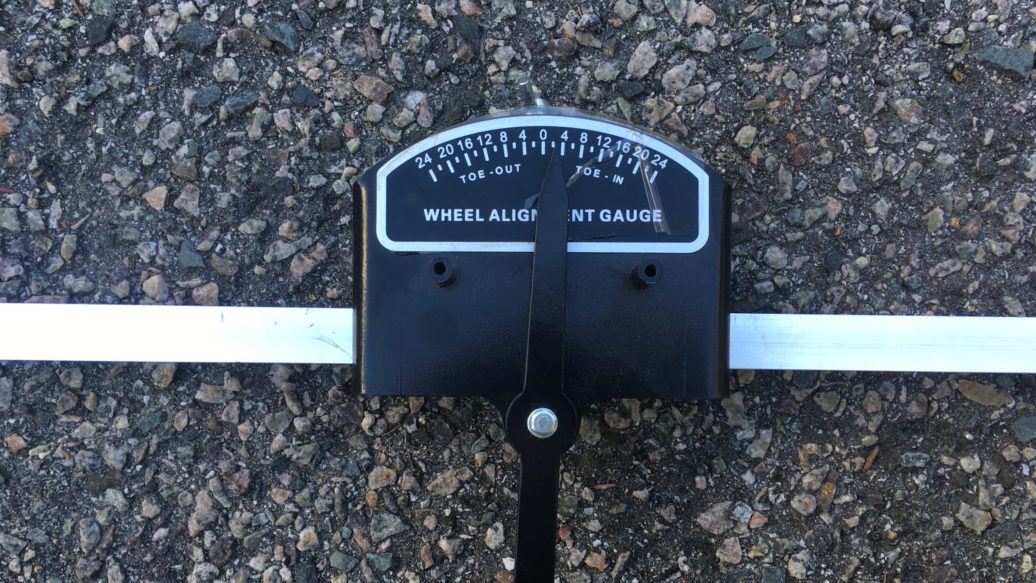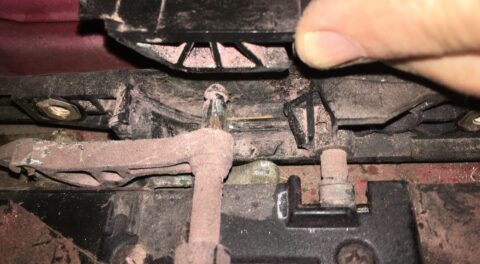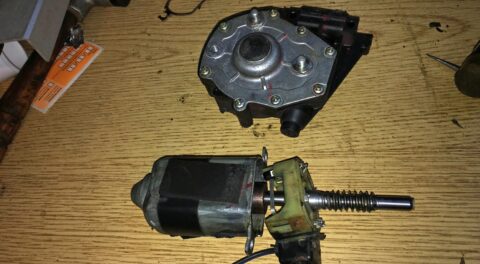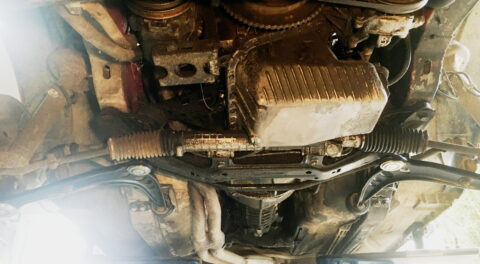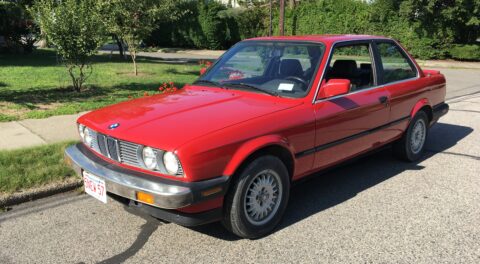It’s usually said that if you do any front-end work on a car, the car is going to need to be re-aligned. By the book, that’s largely true, but in my experience, replacing front-suspension components like struts and control arms with identical replacement parts doesn’t materially affect alignment. It’s replacing steering components, especially tie rods, which have their adjustability built into them via threaded rods, that absolutely requires an alignment afterward.
After such work, I used to dutifully haul my cars in to whatever auto repair chain had a discount coupon for alignment. However, a number of years ago, I began doing front-end alignments myself.
I first tried the string method: stretching a pair of strings from the rear wheels to the front. You can find numerous videos on this on YouTube. But for some reason—lack of attention span, high winds, gravity in my garage, who knows?—the string method didn’t work for me; when I tried it on Louie, the ’72 tii, a few years back, when I drove the car afterward, it felt like the two headlights were trying to drive in different directions.
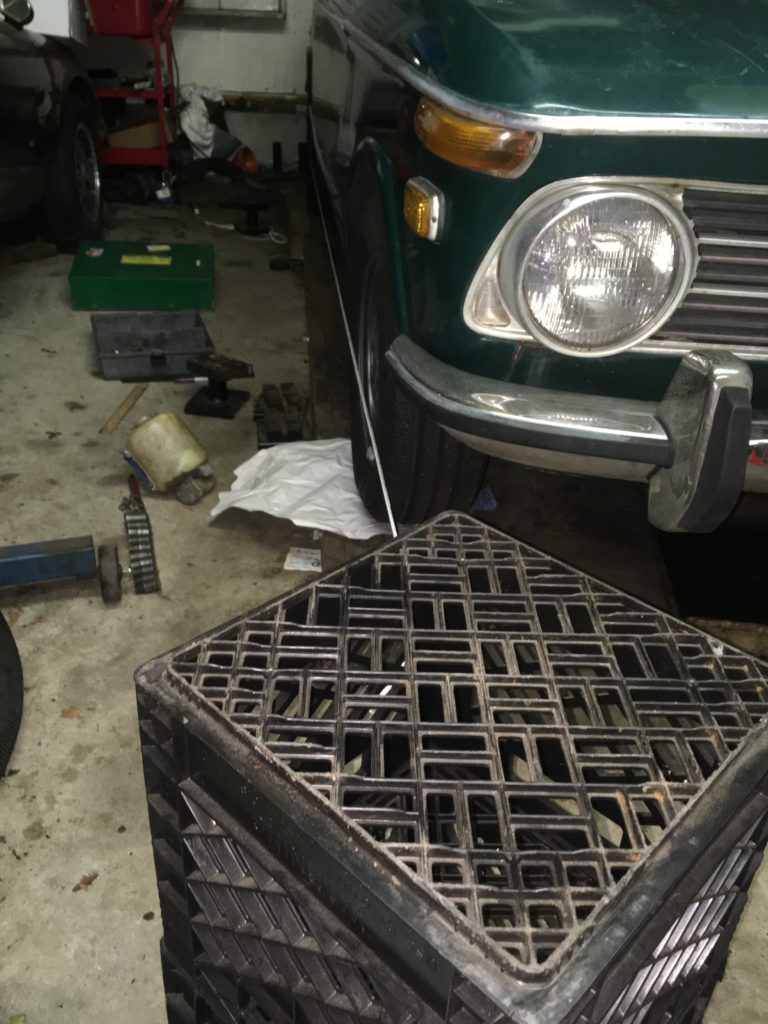
I tried “the string method” with Louie, and was not successful.
There’s another popular do-it-yourself method in which you take a pair of flat, rigid metal plates, lean one of them against each front tire, and use a pair of tape measures on the leading and trailing edges. Pre-packaged “toe-in plates,” with slots cut into them to hold the supplied tape measures, can be bought online for about $60. Although some swear by these, I was skeptical, since even with a pair of identical new tape measures, my ability to reliably measure within a sixteenth of an inch across a span of five feet using a device that sags in the middle is questionable.
So I looked at other methods that don’t provide the actual edge-to-edge measurements for you to subtract, but instead tell you the difference between the two measurements. I bought what’s sometimes called a toe-in gauge: a rigid metal bar with a right angle at one end and a sliding sprung needle indicator at the other. You slide it behind the tires, lift it up, pull it so that the right angle is flush with one tire, slide the indicator against the other tire and adjust it so it reads zero, then flip it around to the front edges of the tires. The reading on the indicator is the toe in or out. These used to be made by Manco; they were available through Eastman, and were popular in British car circles. A similar item was sold for a while by Harbor Freight. I found one from Slugbus available here on eBay for about $60 shipped.
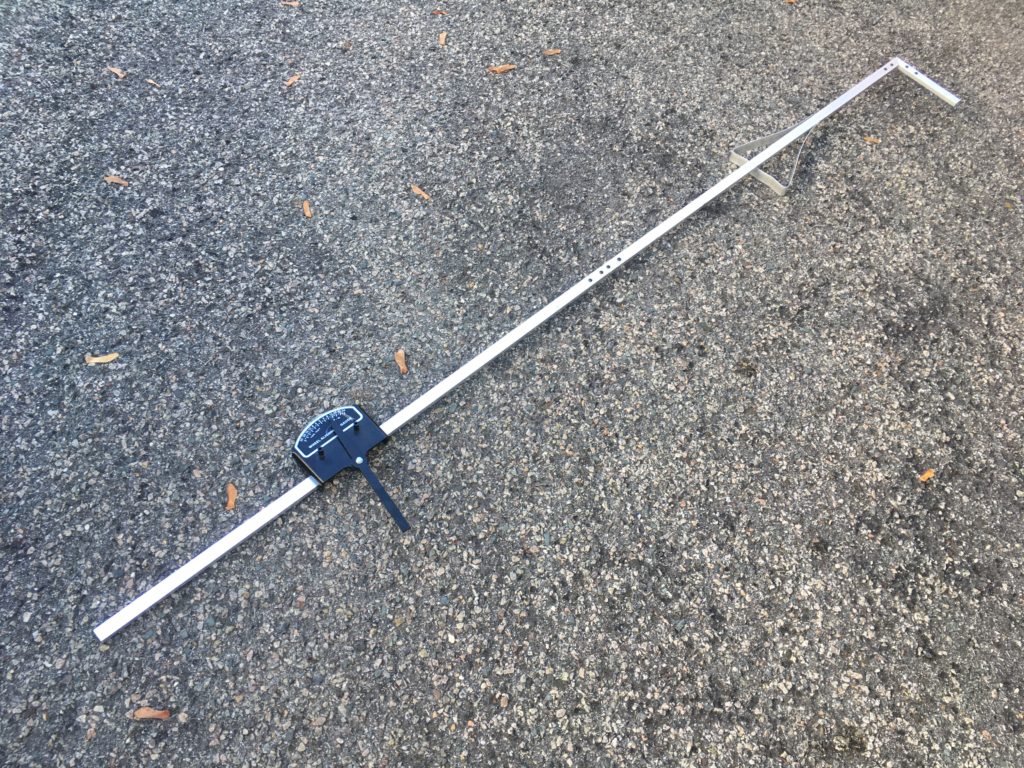
My toe-in gauge, bought last year on eBay.
I used the toe-in gauge last spring on the 2002tii, and while it’s kind of cheesy, it works well enough to be useful. Its main advantage is that it’s fast; as long as you can lift it up behind the front tires to reach the rear edges of both tires without it hitting anything, you can quickly set it to zero at the rear, then flip it around to take the front measurement. It’s got a little flip-out stand on the right-angle end to hold that end a consistent height off the ground.
While any of these tire-based measurements can be thrown off by tire bulge, or by lettering on the sidewall, and are thus never going to be as accurate as something using the hubs or wheels, the toe-in gauge was certainly good enough to get close to zero toe-in. From there I’d typically just tweak it in by feel, adjusting the tie rods to toe it in until I felt the front tires scrubbing, then back it off until I felt the front end wandering, then set it halfway between the two.
The main disadvantage is that the measurement is best done at the midpoint of the tire diameter, where there should be no camber affecting it. There’s no guarantee that the little flip-out stand is going to put that end at the midpoint, and side-to-side height variations of the two ends can throw the alignment measurements off by quite a bit.

The toe-in gauge on the front tires of one of the 2002s.
And when I tried to use the toe-in gauge on the Lotus after I rebuilt its front end, I found that it didn’t work nearly as well as it did on the 2002, because at the rear edge of the Lotus’ front tires, the body of the car itself was in the way, preventing me from lifting the toe-in gauge up behind the tires. When I jacked up the car, it let the front suspension hang, which allowed me to get the gauge closer to the midpoint of the tires, but at the cost of lot of positive camber, which can affect the measurement. It was good enough to get the front alignment in the ballpark, but I also needed to do a rear-wheel alignment on the Lotus, so I began looking at another method.

Any direct edge-to-edge midpoint measurement on the back of the Lotus’ tires is blocked by the body of the car.
There’s another device called a toe-pointer bar, sometimes referred to in old enthusiast circles as a trammel bar. I stumbled across them online when I bought the toe-in gauge, but at the time, I didn’t fully understand their utility. They’re sort of like a giant set of vernier calipers, a bar with sliding brackets at both ends and a dog-legged pointer that sticks up from each bar. One of the sliding brackets moves across the face of a six-inch ruler with sixteenth-inch marks on it. Like the toe-in gauge, it’s not intended to give you an actual distance measurement between tire edges, but instead gives you the difference between the distances at front and back edges.
The advertised utility of the pointer bar is that unlike the toe-in plates or the gauge, the pointer bar isn’t thrown off by the tire sidewall, because you first raise the car, spin each wheel, and use an awl or a screwdriver to scratch a thin line in each tire. Because of the rotation, this line is guaranteed to be parallel to the actual plane of rotation of the wheel and hub. (I cheated by spinning the wheels and verifying that the narrow outer grooves were already straight to less than a sixteenth of an inch.) You set both ends of the pointer bar on the scribed lines, and do the measurement the same way as with the toe-in bar: zero it on the back edge of the tires, move it to the front, and read the difference.
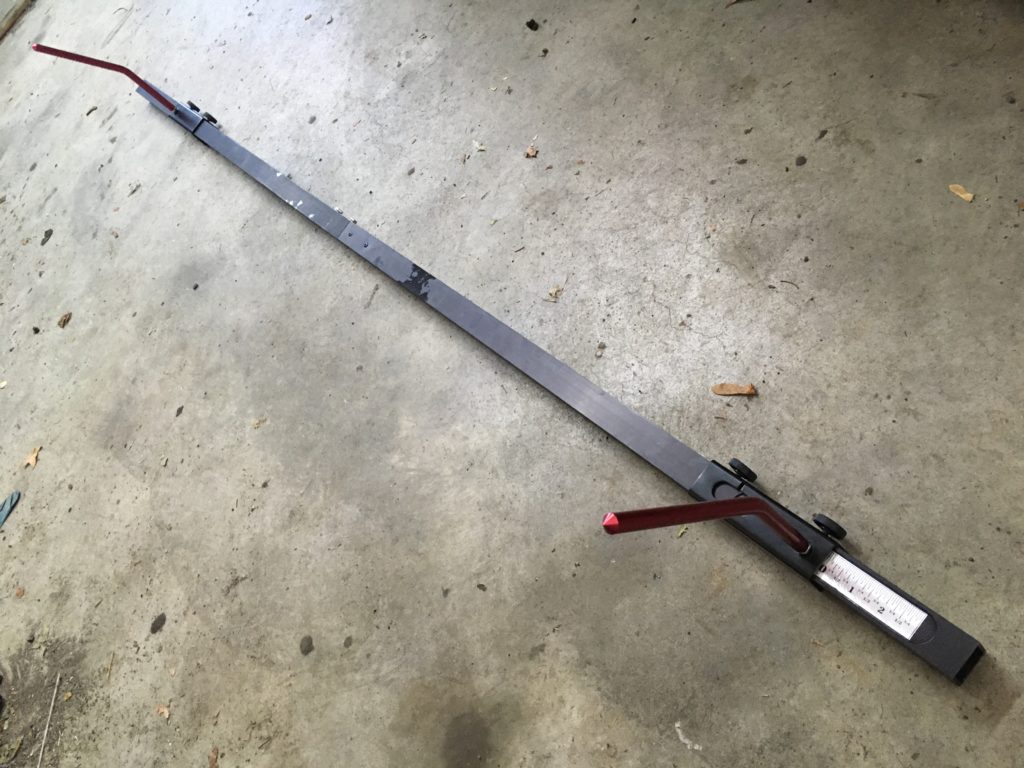
My Speedway toe pointer bar.
Because the bar itself is flat with the pointers sticking up from it, I thought that maybe I could use it on the Lotus by rotating it 90 degrees so that the pointers were horizontal, sliding it under the car, then carefully rotating it up in a way that let the pointers rise up in the small part of the wheel well behind the tires. You could clearly make yourself a toe pointer bar, but when I found that the Speedway model 3008000 pointer bar was available for about $80 shipped from Amazon, I thought that I’d try it and return it if it wasn’t more useful to me than the toe-in gauge.
While the rotate-it-slide-it-flat-rotate-it-back-up maneuver worked, as it turns out, there is a much better way to use it that I didn’t predict, and that I hadn’t read anywhere, that makes it incredibly useful on any low car where the body precludes the use of tape measures or a toe-in gauge.

Zeroing the ruler end of the pointer bar before flipping it around.
What you do is remove one bracket and pointer at a time. That is, to get behind the front tires, you set the bracket and pointer on the ruler end to read zero, then take the bracket and pointer off the other end. With nothing on that end, you can now slide it under the car without hitting anything. You then align the pointer on the ruler end with the scribe mark on its tire, slide the bracket and pointer onto the other end, and align that to its scribe mark. Once you’ve adjusted it so that both marks are dead-on, you tighten the bracket at the end without the ruler, remove the bracket on the ruler end, and slide the bar out. You then flip it around to the front edge of the tires, put the bracket at the ruler end back on, and adjust only that bracket while lining up the pointers.
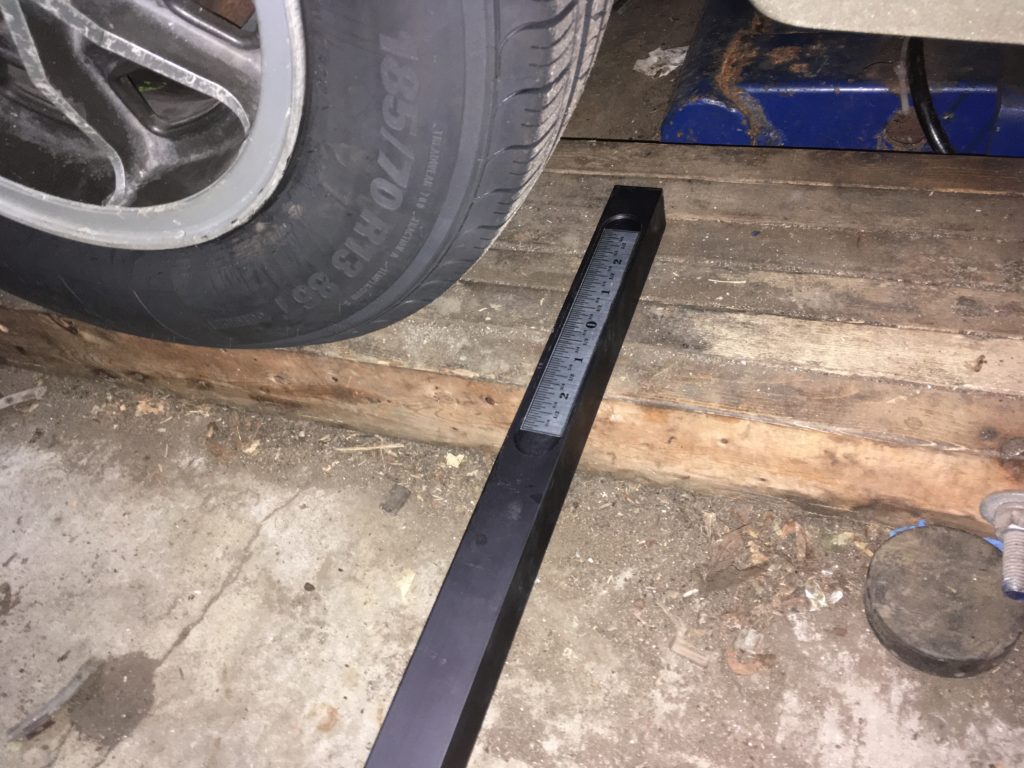
Sliding one end of the pointer bar under the car with the bracket and pointer off.
The downsides of the pointer bar are that using it is slower than the toe-in gauge, you may need to stand it on blocks to reach the midpoint of the tires, and swinging around anything with those pointers risks nicking the paint on the car—but I found that the readings were much more consistent than with the toe-in gauge. I’ll still probably use the toe-in gauge for the vintage cars with lots of clearance behind the wheel wells, but if I need to do front-end work on a low car like the Z3 M coupe, this pointer bar will be a great tool to have in the arsenal.—Rob Siegel
Rob’s latest book, The Lotus Chronicles: One man’s sordid tale of passion and madness resurrecting a 40-year-dead Lotus Europa Twin Cam Special, is now available here on Amazon. Signed copies of this and his other books can be ordered directly from Rob here.

